5.1 Basic Concepts of Sensation and Perception
LOQ LearningObjectiveQuestion
5-
sensation the process by which our sensory receptors and nervous system receive and represent stimulus energies from our environment.
perception the process by which our brain organizes and interprets sensory information, transforming it into meaningful objects and events.
Sellers’ curious mix of “perfect vision” and face blindness illustrates the distinction between sensation and perception. When she looks at a friend, her sensation is normal. Her senses detect the same information yours would, and they transmit that information to her brain. And her perception—the processes by which her brain organizes and interprets the sensory input—
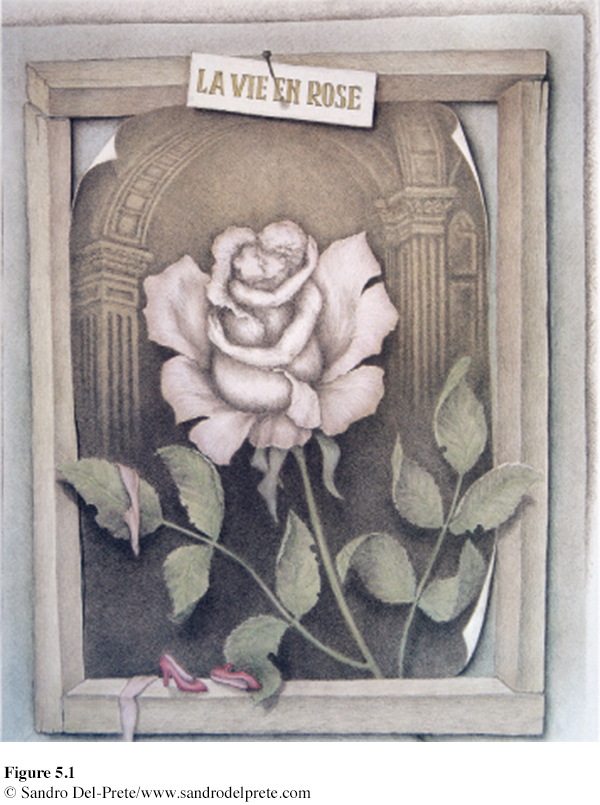
Under normal circumstances, your sensory and perceptual processes work together to help you decipher the world around you.
bottom-
Bottom-
up processing starts at the very basic level of sensory receptors (more on those later) and works up to higher levels of processing.top-
down processing information processing guided by higher-level mental processes, as when we construct perceptions drawing on our experience and expectations. Top-
down processing creates meaning from the sensory input by drawing on your experience and expectations.
As your brain absorbs the information in FIGURE 5.1, bottom-
But how do you do it? How do you create meaning from the blizzard of sensory stimuli bombarding your body 24 hours a day? Meanwhile, in a silent, cushioned, inner world, your brain floats in utter darkness. By itself, it sees nothing. It hears nothing. It feels nothing. So, how does the world out there get in?
To phrase the question scientifically: How do we construct our representations of the external world? How do a campfire’s flicker, crackle, and smoky scent activate pathways in our brain? And how, from this living neurochemistry, do we create our conscious experience of the fire’s motion and temperature, its aroma and beauty? In search of answers, let’s look at some processes that cut across all our sensory systems.
From Outer Energy to Inner Brain Activity
LOQ 5-
Every second of every day, your sensory systems perform an amazing feat: They convert one form of energy into another. Vision processes light energy. Hearing processes sound waves. All your senses
receive sensory stimulation, often with the help of specialized receptor cells.
transform that stimulation into neural impulses.
deliver the neural information to your brain.
transduction changing one form of energy into another. In sensation, the transforming of stimulus energies, such as sights, sounds, and smells, into neural impulses our brain can interpret.
The process of converting one form of energy into another form that your brain can use is transduction. Later in this chapter, we’ll focus on individual sensory systems. How do we see? Hear? Feel pain? Taste? Smell? Keep our balance? In each case, we’ll consider these three steps—
First, though, let’s explore some strengths and weaknesses in our ability to detect and interpret stimuli in the vast sea of energy around us.
Retrieve + Remember
Question 5.1
•What is the rough distinction between sensation and perception?
ANSWER: Sensation is the bottom-
Thresholds
LOQ 5-
At this moment, we are being struck by X-
Our senses open the shades just a crack, giving us only a tiny glimpse of the energy around us. But for our needs, this is enough.
Absolute Thresholds
To some kinds of stimuli we are amazingly sensitive. Standing atop a mountain on a dark, clear night, most of us could see a candle flame atop another mountain 30 miles away. We could feel the wing of a bee falling on our cheek. We could smell a single drop of perfume in a three-
absolute threshold the minimum stimulus energy needed to detect a particular stimulus 50 percent of the time.
Our awareness of these faint stimuli illustrates our absolute thresholds—the minimum stimulation needed to detect a particular light, sound, pressure, taste, or odor 50 percent of the time. To test your absolute threshold for sounds, a hearing specialist would send tones, at varying levels, into each of your ears and record whether you could hear each tone. The test results would show the point where, for any sound frequency, half the time you could detect the sound and half the time you could not. That 50-
subliminal below a person’s absolute threshold for conscious awareness.
 See LaunchPad’s Video: Experiments for a helpful tutorial animation about the experimental research method.
See LaunchPad’s Video: Experiments for a helpful tutorial animation about the experimental research method.
Stimuli you cannot detect 50 percent of the time are subliminal—below your absolute threshold (FIGURE 5.2). To consider their effects, see Thinking Critically About: Subliminal Sensation and Subliminal Persuasion.
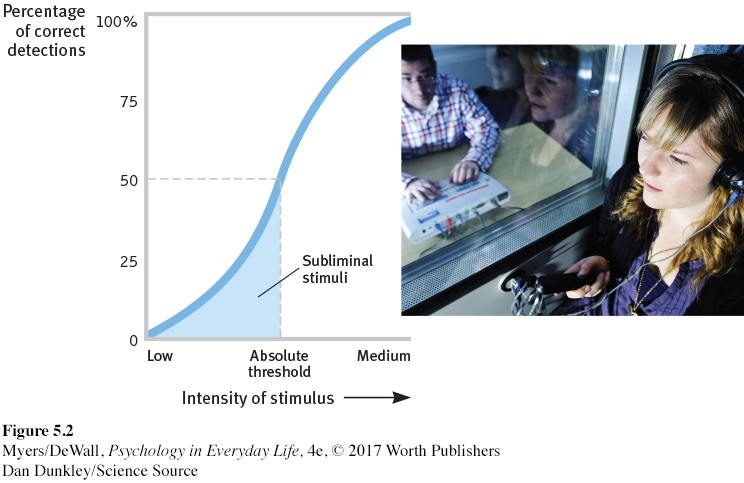
Difference Thresholds
To function effectively, we need absolute thresholds low enough to allow us to detect important sights, sounds, textures, tastes, and smells. Many of life’s important decisions also depend on our ability to detect small differences among stimuli. A musician must detect tiny differences when tuning an instrument. Parents must detect the sound of their own child’s voice amid other children’s voices. Even after I [DM] had lived two years in Scotland, all lambs’ baas sounded alike to my ears. But not to their mother’s, as I observed. After shearing, each ewe would streak directly to the baa of her lamb amid the chorus of other distressed lambs.

difference threshold the minimum difference between two stimuli required for detection 50 percent of the time. We experience the difference threshold as a just noticeable difference (or jnd).
The difference threshold (or the just noticeable difference [ jnd]) is the minimum difference a person can detect between two stimuli half the time. That detectable difference increases with the size of the stimulus. If we listen to our music at 40 decibels, we might detect an added 5 decibels. But if we increase the volume to 110 decibels, we probably won’t then detect an additional 5-
LOQ 5-
priming activating, often unconsciously, associations in our mind, thus setting us up to perceive, remember, or respond to objects or events in certain ways.
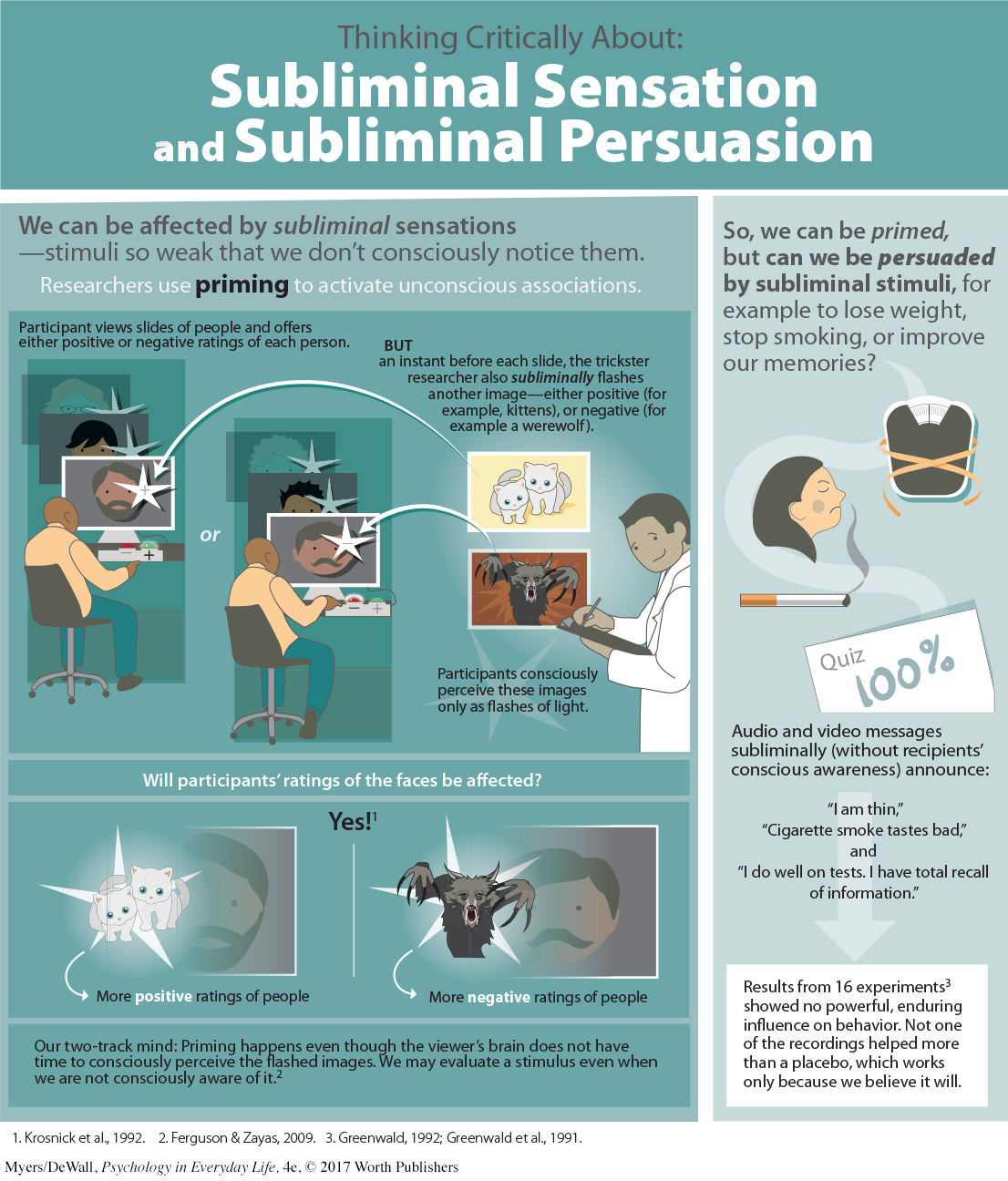
Weber’s law the principle that, to be perceived as different, two stimuli must differ by a constant minimum percentage (rather than a constant amount).
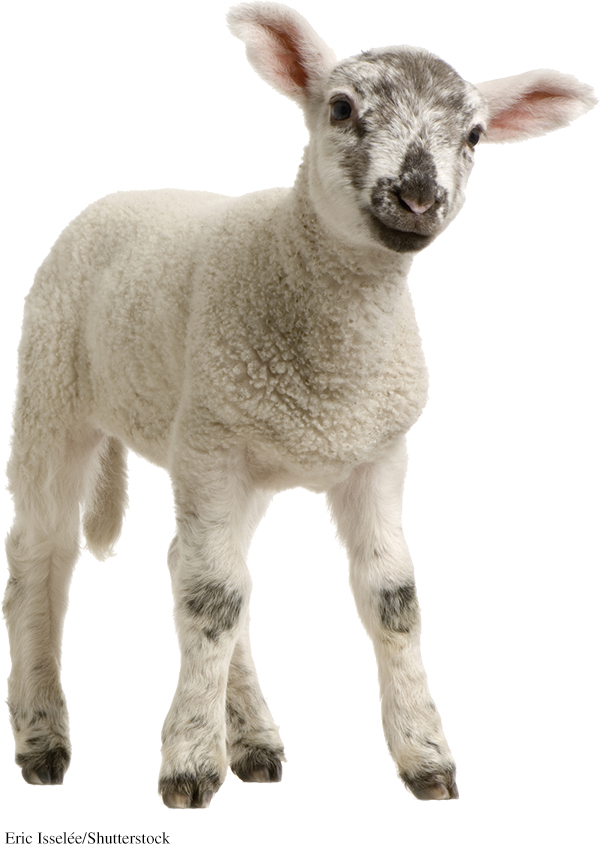
In the late 1800s, Ernst Weber noted something so simple and so useful that we still refer to it as Weber’s law. It states that for an average person to perceive a difference, two stimuli must differ by a constant minimum percentage (not a constant amount). The exact percentage varies, depending on the stimulus. Two lights, for example, must differ in intensity by 8 percent. Two objects must differ in weight by 2 percent. And two tones must differ in frequency by only 0.3 percent (Teghtsoonian, 1971).
Retrieve + Remember
Question 5.2
•Using sound as your example, show how these concepts differ: absolute threshold, subliminal stimulation, and difference threshold.
ANSWER: Absolute threshold is the minimum stimulation needed to detect a particular sound (such as an approaching bike on the sidewalk behind you) 50 percent of the time. Subliminal stimulation happens when, without your awareness, your sensory system processes a sound that is below your absolute threshold. A difference threshold is the minimum difference needed to distinguish between two stimuli (such as between the sound of a bike and the sound of a runner coming up behind you).
Sensory Adaptation
LOQ 5-
sensory adaptation reduced sensitivity in response to constant stimulation.
Sitting down on the bus, you are overwhelmed by your seatmate’s heavy perfume. You wonder how she can stand it, but within minutes you no longer notice. Sensory adaptation has come to your rescue. When constantly exposed to an unchanging stimulus, we become less aware of it because our nerve cells fire less frequently. (To experience sensory adaptation, roll up your sleeve. You will feel it—
“We need above all to know about changes; no one wants or needs to be reminded 16 hours a day that his shoes are on.”
Neuroscientist David Hubel (1979)
Why, then, if we stare at an object without flinching, does it not vanish from sight? Because, unnoticed by us, our eyes are always moving. This continual flitting from one spot to another ensures that stimulation on the eyes’ receptors is always changing.
What if we actually could stop our eyes from moving? Would sights seem to vanish, as odors do? To find out, psychologists have designed clever instruments that maintain a constant image on the eye’s inner surface. Imagine that we have fitted a volunteer, Mary, with such an instrument—
If we project images through this instrument, what will Mary see? At first, she will see the complete image. But within a few seconds, as her sensory system begins to tire, things will get weird. Bit by bit, the image will vanish, only to reappear and then disappear—
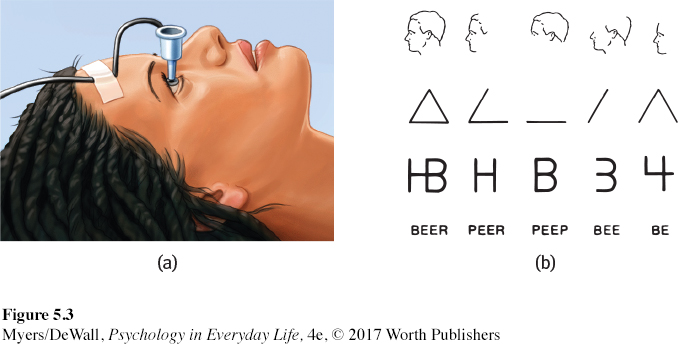
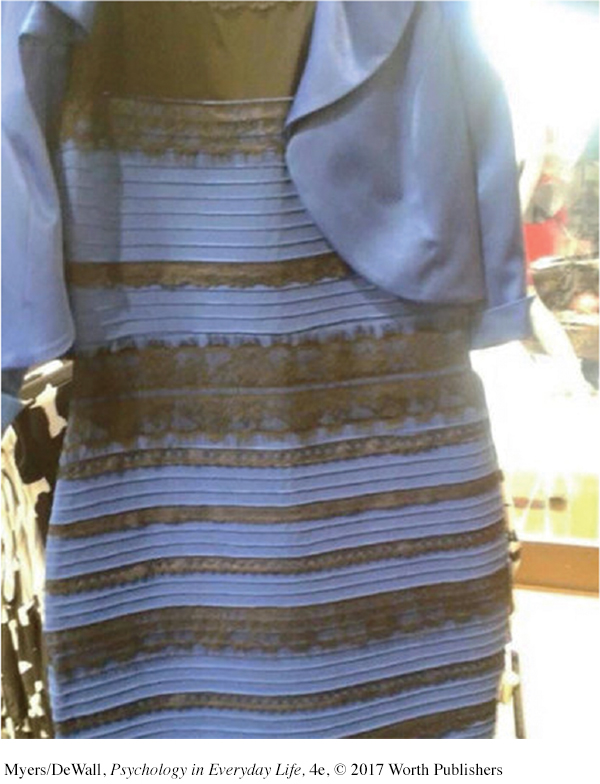
Although sensory adaptation reduces our sensitivity, it offers an important benefit. It frees us to focus on informative changes in our environment without being distracted by background chatter. The attention-
Sensory adaptation influences our perceptions of emotions, too. By creating a 50-
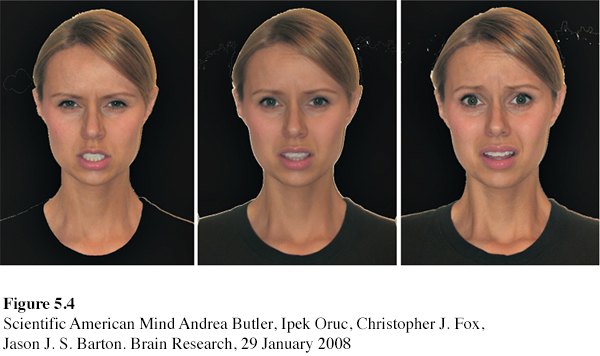
The point to remember: Our sensory receptors are alert to novelty; bore them with repetition and they free our attention for more important things. We will see this principle again and again: We perceive the world not exactly as it is, but as it is useful for us to perceive it.
Retrieve + Remember
Question 5.3
•Why is it that after wearing shoes for a while, you cease to notice them (until questions like this draw your attention back to them)?
ANSWER: The shoes provide constant stimulation. Thanks to sensory adaptation, we tend to focus primarily on changing stimuli.
Perceptual Set
LOQ 5-
perceptual set a mental predisposition to perceive one thing and not another.
When shown the phrase
Mary had a
a little lamb
many people perceive what they expect and miss the repeated word. Did you?
To see is to believe. As we less fully appreciate, to believe is to see. Through experience, we come to expect certain results. Those expectations may give us a perceptual set, a set of mental tendencies and assumptions that affects, top-
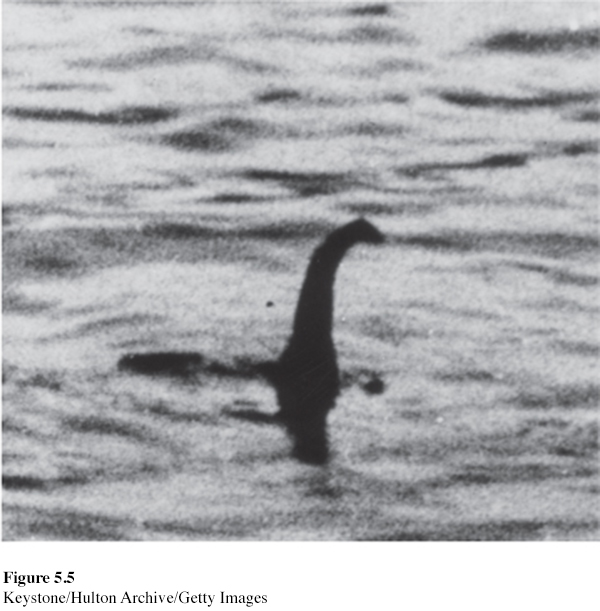
To believe is also to hear. Consider the kindly airline pilot who, on a takeoff run, looked over at his unhappy co-
Our expectations can also influence our taste perceptions. In one experiment, preschool children, by a 6-
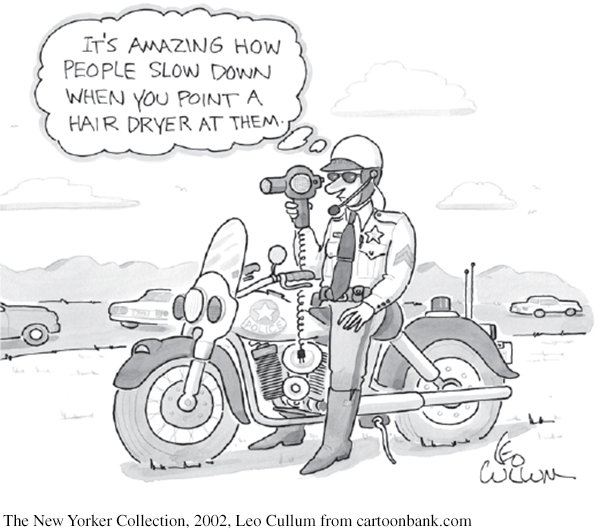
Context, Motivation, and Emotion
Perceptual set influences how we interpret stimuli. But our immediate context, and the motivation and emotion we bring to a situation, also affect our interpretations.
CONTEXT EFFECTS Social psychologist Lee Ross invited us to recall our own perceptions in different contexts: “Ever notice that when you’re driving you hate pedestrians, the way they saunter through the crosswalk, almost daring you to hit them, but when you’re walking you hate drivers?” (Jaffe, 2004).
Some other examples of the power of context:
When holding a gun, people become more likely to perceive another person as also gun-
toting— a perception that has led to the shooting of some unarmed people who were actually holding their phone or wallet (Witt & Brockmole, 2012). Imagine hearing a noise interrupted by the words “eel is on the wagon.” Likely you would actually perceive the first word as wheel. Given “eel is on the orange,” you would more likely hear peel. In each case, the context creates an expectation that, top-
down, influences our perception (Grossberg, 1995). Depending on our perceptual set, “rhapsody” may become “rap city,” “sects” may become “sex,” and “meteorologist” may be heard as the muscular “meaty urologist.” Cultural context helps form our perceptions, so it’s not surprising that people from different cultures view things differently, as in FIGURE 5.6.
How is the woman in FIGURE 5.7 feeling?
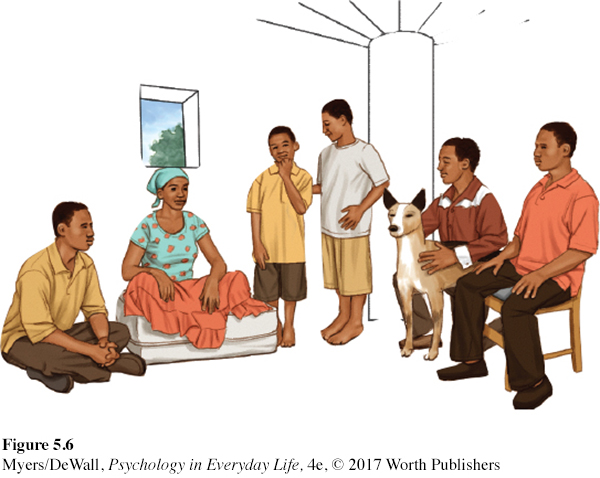
MOTIVATION Motives give us energy as we work toward a goal. Like context, they can bias our interpretations of neutral stimuli. Consider these findings.
Desirable objects, such as a water bottle viewed by a thirsty person, seem closer than they really are (Balcetis & Dunning, 2010).
Page 140A softball appears bigger when players are hitting well (Witt & Proffitt, 2005).

EMOTION Other clever experiments have demonstrated that emotions can shove our perceptions in one direction or another.
Hearing sad music can tilt the mind toward hearing a spoken word as mourning rather than morning, as die rather than dye, as pain rather than pane (Halberstadt et al., 1995).
A hill seems less steep to people who feel others understand them (Oishi et al., 2013).
A harmful action, such as robbery, seems more serious to those who have just listened to irritating (and anger-
cuing) music (Seidel & Prinz, 2013).
The moral of all these examples? Much of what we perceive comes not just from what’s “out there,” but also from what’s behind our eyes and between our ears. Through top-
Retrieve + Remember
Question 5.4
•Does perceptual set involve bottom-
ANSWER: It involves top-
* * *
The processes we’ve discussed so far are features shared by all our sensory systems. Let’s turn now to the ways those systems are unique. We’ll start with our most prized and complex sense, vision.
